robutacion
Member
Hi peoples,
A couple of weeks ago, I brought to the house a trailer full of various pieces of wood that I had stored in my open storage paddock, with the rains starting to come in, I wanted to get some of the wood I had there, store under cover to dry all the moisture from rain from these last few weeks.
One of the pieces that I picked up was a few cuts from an old 4"slab that was buried in sand, on the block of land where I got the gigantic Red Gum stump, the size of a small car. This slab (about 8' long) had cracked straight through the center, only attached at one end, like a table fork, 3 long fingers...!
I simply thought that was a slab from the Red Gum tree that lived there and was cut down and slabbed on site, the wood was all dirty and dark from being in the dirt/sand for about 10 years or so.
I remember the slab was heavy as hell but, all the wood I got from that location was soaked wet from lots of rain so, I didn't make much more to it. Some of the wood I wanted to bring home from my storage paddock was some of the old curly Red Gum very difficult to spot until it gets dressed and coated with something so, I cut 4 pieces @ 1' long from those "fingers" and when I got home, I got a big surprised with it, it wasn't Red Gum not even close to it, yelish wood, very tight grain with density that I compared with lignum Vitae, and its called Eucalyptus Dura (dura means, hard...!)
Before I even worried about finding out what it was, certainly not one of my 80 species and reason what it is now species #81, I though of its similarities to Ebony so, I wondered, if I could make it black, stabilizing it with a very strong mix of black Alumilite black dye.
Well, I had 5 blanks in a square ice-cream container well covered with the black juice, I had them under full vacuum for 9 hours, stop the pump, open the lid and left them soak overnight, about lunch time the next day, I put them under vacuum again for another 6 hours, left then again in the black juice another overnight.
The next day I took them out of the juice and let them drain for a couple of hours, after of which I proceeded to wrap in foil and cook them for 90 minutes @ 90° celsius. Hardly any excess juice was seen so, they looked quite clean, considering how some blanks look after stabilized.
Yes, they were all nice and black, but I did doubt that, this dying process, in conjunction with the Cactus Juice, was going to work, the wood did certainly not need stabilizing but, I used the juice and a tool to facilitated the black dye to penetrate into that hard wood, if any at all..!
So, I wasn't surprised when, I put 1 blank in between centers and took it for a spin. I didn't need to fo far, the black dye was coating the wood surface as a coat of spray paint, all stayed on the wood surface and absolutely no penetration at all of the dye, nor the Cactus juice. The blanks were weighed before and after, the the weight did not change at all...!
Like I said, the results weren't a surprised, I didn't think this wood would allow any soaking of anything, even under full vacuum, it may be a different store, if subjected to 5,000 PSI pressure used in some of the commercial stabilizers, even though, I have my doubts...!
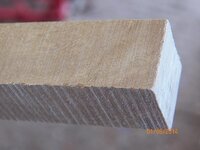
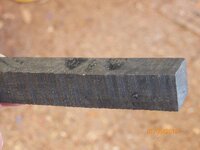
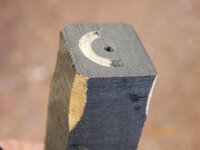
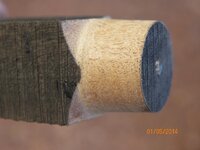
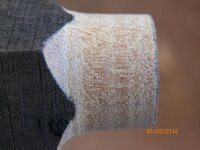
So, why did I try to make this wood black...???
Well, my first thought when I saw what I had was, "finials", I could tell from the way the wood was behaving on the bandsaw that, this wood would allow very thin turnings, the very reason why most turners use the black Ebony.
Could I make this wood black and sell it for this type of work..??? no, I can't however, is the wood less suitable because is not black...??? absolutely not, and to prove that, I grabbed a half raw/natural colour blank and mount it on my lathe chuck.
Did it turn/cut as I expected...??? absolutely, what a pleasure to work with, is one of those woods that, if you rub the gouge bevel on the wood as you go, it shines up and almost doesn't require sanding, is smooth as...!
So, how easy would it be to turn a finial a few inches long, and turned to a sharp point, like a needle (believe me, is sharp)...? well, very easily indeed, it too absolutely no time. I sanded it slightly with some 240 grit sand paper, I didn't sand it as smooth as I could, this was a test and part 1 of it was done, part 2 was making it black.
Well, that was even easier than turn it, I could have used one of half a dozen possibilities, such as the Alumilite dye, black wood stain, black paint, black shoe polish, etc, etc. but, I took the black marker I had in my shirt pocket, let it dry and then rub it slightly with a clean paper towel, absolutely nothing else after that.
While it looks good, is not protected, it would require one of various ways of sealing it, I would use super thin CA or a wood sealer in spray and give it a thin coat couple of coats. Depending if the sealer spray is matt, satin or gloss, as the CA would be gloss and the intended finish a satin type, any gloss would be easily removed with some fine steel wool, adjusting the amount of shine, that way...!
I didn't do any of that, I simply turned it thin and make the wood black, and if I hadn't tell you all this, and show you the finial, showing only the black part, you would be thinking that is was black Ebony, huh...???:wink::biggrin:
My point, precisely...!
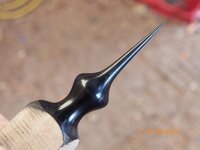
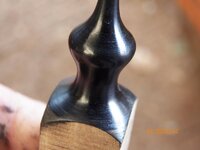
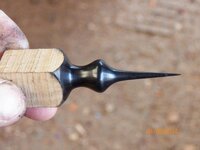
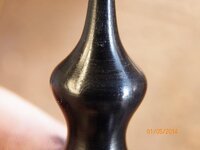
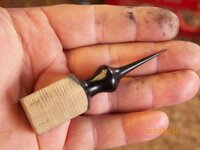
Can you make pens out of this wood/blanks, using the same principles...??? what do you reckon...???, I would say, absolutely, a black Ebony, a bog-oak, a buffalo horn, look alike for bugger all cost...!
Enjoy...!
Cheers
George
A couple of weeks ago, I brought to the house a trailer full of various pieces of wood that I had stored in my open storage paddock, with the rains starting to come in, I wanted to get some of the wood I had there, store under cover to dry all the moisture from rain from these last few weeks.
One of the pieces that I picked up was a few cuts from an old 4"slab that was buried in sand, on the block of land where I got the gigantic Red Gum stump, the size of a small car. This slab (about 8' long) had cracked straight through the center, only attached at one end, like a table fork, 3 long fingers...!
I simply thought that was a slab from the Red Gum tree that lived there and was cut down and slabbed on site, the wood was all dirty and dark from being in the dirt/sand for about 10 years or so.
I remember the slab was heavy as hell but, all the wood I got from that location was soaked wet from lots of rain so, I didn't make much more to it. Some of the wood I wanted to bring home from my storage paddock was some of the old curly Red Gum very difficult to spot until it gets dressed and coated with something so, I cut 4 pieces @ 1' long from those "fingers" and when I got home, I got a big surprised with it, it wasn't Red Gum not even close to it, yelish wood, very tight grain with density that I compared with lignum Vitae, and its called Eucalyptus Dura (dura means, hard...!)
Before I even worried about finding out what it was, certainly not one of my 80 species and reason what it is now species #81, I though of its similarities to Ebony so, I wondered, if I could make it black, stabilizing it with a very strong mix of black Alumilite black dye.
Well, I had 5 blanks in a square ice-cream container well covered with the black juice, I had them under full vacuum for 9 hours, stop the pump, open the lid and left them soak overnight, about lunch time the next day, I put them under vacuum again for another 6 hours, left then again in the black juice another overnight.
The next day I took them out of the juice and let them drain for a couple of hours, after of which I proceeded to wrap in foil and cook them for 90 minutes @ 90° celsius. Hardly any excess juice was seen so, they looked quite clean, considering how some blanks look after stabilized.
Yes, they were all nice and black, but I did doubt that, this dying process, in conjunction with the Cactus Juice, was going to work, the wood did certainly not need stabilizing but, I used the juice and a tool to facilitated the black dye to penetrate into that hard wood, if any at all..!
So, I wasn't surprised when, I put 1 blank in between centers and took it for a spin. I didn't need to fo far, the black dye was coating the wood surface as a coat of spray paint, all stayed on the wood surface and absolutely no penetration at all of the dye, nor the Cactus juice. The blanks were weighed before and after, the the weight did not change at all...!
Like I said, the results weren't a surprised, I didn't think this wood would allow any soaking of anything, even under full vacuum, it may be a different store, if subjected to 5,000 PSI pressure used in some of the commercial stabilizers, even though, I have my doubts...!





So, why did I try to make this wood black...???
Well, my first thought when I saw what I had was, "finials", I could tell from the way the wood was behaving on the bandsaw that, this wood would allow very thin turnings, the very reason why most turners use the black Ebony.
Could I make this wood black and sell it for this type of work..??? no, I can't however, is the wood less suitable because is not black...??? absolutely not, and to prove that, I grabbed a half raw/natural colour blank and mount it on my lathe chuck.
Did it turn/cut as I expected...??? absolutely, what a pleasure to work with, is one of those woods that, if you rub the gouge bevel on the wood as you go, it shines up and almost doesn't require sanding, is smooth as...!
So, how easy would it be to turn a finial a few inches long, and turned to a sharp point, like a needle (believe me, is sharp)...? well, very easily indeed, it too absolutely no time. I sanded it slightly with some 240 grit sand paper, I didn't sand it as smooth as I could, this was a test and part 1 of it was done, part 2 was making it black.
Well, that was even easier than turn it, I could have used one of half a dozen possibilities, such as the Alumilite dye, black wood stain, black paint, black shoe polish, etc, etc. but, I took the black marker I had in my shirt pocket, let it dry and then rub it slightly with a clean paper towel, absolutely nothing else after that.
While it looks good, is not protected, it would require one of various ways of sealing it, I would use super thin CA or a wood sealer in spray and give it a thin coat couple of coats. Depending if the sealer spray is matt, satin or gloss, as the CA would be gloss and the intended finish a satin type, any gloss would be easily removed with some fine steel wool, adjusting the amount of shine, that way...!
I didn't do any of that, I simply turned it thin and make the wood black, and if I hadn't tell you all this, and show you the finial, showing only the black part, you would be thinking that is was black Ebony, huh...???:wink::biggrin:
My point, precisely...!





Can you make pens out of this wood/blanks, using the same principles...??? what do you reckon...???, I would say, absolutely, a black Ebony, a bog-oak, a buffalo horn, look alike for bugger all cost...!
Enjoy...!
Cheers
George
Last edited:
